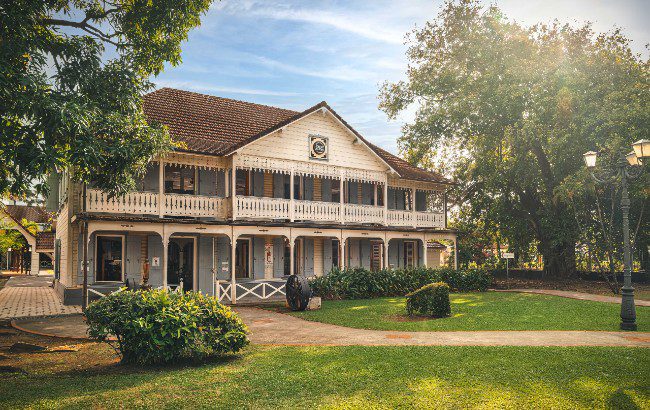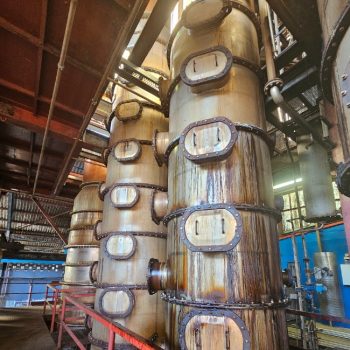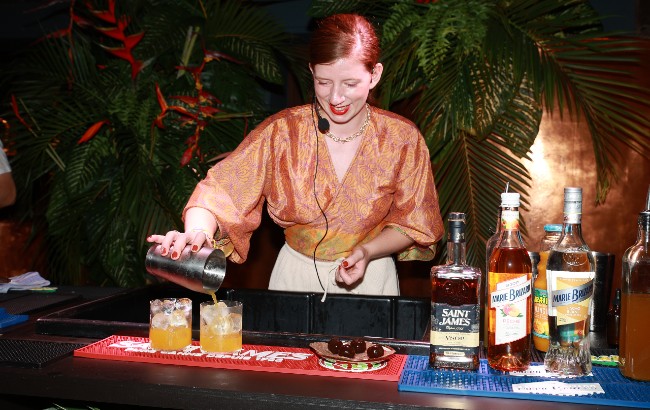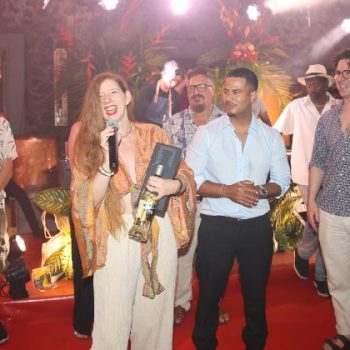SB visits… Martinique with Saint James agricole rum
By Melita KielyMartinique served up a healthy measure of history, world-class mixology and Ti’ Punch cocktails in July – delve deeper into the island, home of Saint James agricole rum, as we recall a recent visit.

For 260 years, Saint James Distillery has been a pioneer of agricole rum. At the latest edition of the annual Bartenders Society cocktail competition, we got up close and personal with this historic distillery to learn more about its rich history.
Lush rainforests, rugged volcanic landscapes, golden beaches and crystal-clear waters – Martinique is a stunning Caribbean island in the Lesser Antilles. An overseas region of France, the island is a wonderful mix of French and West Indian cultures.
Distilling is a huge part of the island’s history. If you leave here without sipping several Ti’ Punch cocktails, you’re doing something wrong…
It was 1765 when Martinique became one of the most prolific sugar islands in the Caribbean. Saint James dates back to 1765 when father Lefébure, superior of the Fathers of Charity, founded the Trou-Vaillant sugar refinery in Martinique. Father Lefébure, who had already been making sugarcane brandy, committed to creating rum. However, it was more than a century later in 1882 that the name ‘Saint James’ was officially registered, and a few years later in 1885 that the inaugural Saint James 1885 was released.
In 1902, an eruption from the island’s Mount Pelée volcano partially destroyed the distillery. But demand for Saint James from that point on only grew. Then, in 1973 the distillery found itself under new ownership after being acquired by Cointreau.
More than two decades later in 1996, Martinique’s rum production officially gained its AOC, appellation d’origine contrôlée, protecting its origins and manufacturing processes.
Today, Saint James is under the ownership of La Martiniquaise-Bardinet and has been part of the company’s portfolio since 2003, following the sale by the merged Rémy Cointreau. La Martiniquaise-Bardinet, whose vast portfolio also includes Label 5 and Glen Moray Scotch whiskies and Generous Gin, prides itself on being the leading group producing and distributing European AOC agricole rum.

Sustainability at the heart of Saint James
During the latest edition of The Bartenders Society global cocktail competition, which took place in Martinique in July, The Spirits Business was in the thick of the action. Before the final got under way, we hitched a ride on the Saint James distillery train to the sugarcane fields to immerse ourselves in the production process and history of the site. Towering metres above our heads, Saint James uses type ‘C4’ sugarcane, the variety that captures the most carbon dioxide. After distillation, the distillery is committed to creating minimal waste, and after pressing the sugarcane to extract the juice for distillation, Saint James takes the bagasse (the fibres left after pressing), which are used to make steam to operate the distillation columns and sugarcane crushing mills.
And it doesn’t stop there. Other parts of the bagasse are composted or turned into electricity, while the vinasse (the liquid residue from distillation) is treated to obtain water, which irrigates the sugarcane fields.
Wandering the distillery grounds gives an old-meets-new experience. There’s the historic sugar refinery, which has been transformed into Habitation La Salle, a visitor centre that opened to the public in 2019 to showcase the story of Martinique’s agricole rum. And old parts of the distillery can be toured, bringing to life the centuries-old production processes.
As we headed towards the fermentation tanks and stills, the heat from the machinery added to the island’s humidity, while filling the air with sweet, sugarcane aromas and additional fruity notes. It was the perfect invitation into the distillery’s warehouse and the chance to sample some rum straight from the barrel. This was a memorable insight into the maturation part of production and a reminder of the breadth of rums the brand creates.
Saint James is renowned for its white rum selections, such as Saint James Impérial Blanc Agricole, and its older offerings, including the likes of its Rhum Vieux VSOP, 12-year-old, 15-year-old and 18-year-old expressions, the latter of which launched last year.
Exploring the distillery and discovering the rich history of Saint James was a fitting warm up to the start of the global final of The Bartenders Society 2025 cocktail competition, held in partnership with Marie Brizard Wine & Spirits (which celebrates its 270th anniversary this year). Held on the distillery grounds, competitors from 14 countries gathered to create two cocktails for the chance to be crowned the 2025 champion – a milestone 10-year anniversary for the contest. Competitors hailed from mainland France, Spain, Portugal, Italy, Belgium, Germany, the UK, Denmark, Greece, the US, Canada, Poland, Brazil (competing for the first time) and Martinique.
Winners demonstrate the best of mixology

Seven experts formed the judging panel this year: Nathalie Hobe, international brand ambassador for Marie Brizard and founder of Nomad Spirits Agency; Ian Burrell, global rum ambassador; Kate Boushel, an award-winning bartender and partner – education and strategic partnerships for the Barocco Group; Daniele Dalla Pola, creator of Alamea Liqueurs and the upcoming Voyage brand; Javier De Las Muelas, founder of the Gimlet and Dry Martini Organisation; and Ned Ratcliffe, bartender and winner of The Bartenders Society 2024.
Each finalist was tasked with creating two cocktails in eight minutes. The first had to be an alcoholic option using Saint James rum and Marie Brizard ingredients. The second had to be an alcohol-free option, using items from Marie Brizard’s portfolio, such as syrups and Caraïbos juices.
Soaring to victory was Alexandra Tsatsouli from the Naked Athens bar in Greece. Her first creation was Banana Breadown, made with Saint James VSOP, Marie Brizard Peach Syrup, Marie Brizard White Cacao Liqueur, and Ethiopian cold brew that was milk-clarified and infused with banana bread cake. She explained how her aim with this drink was to take familiar aromas and flavours, like coffee and banana bread, to stir up nostalgic memories for the judges.
Her winning non-alcoholic concoction, titled Sun-Kissed Wish, included Caraïbos mango juice, homemade lemongrass juice, Marie Brizard Passion Fruit Syrup infused with ginger and basil, and a few drops of saline solution. This creation was born on her birthday, inspired by a personal goal Tsatsouli had set herself to celebrate in a different country each year (which she also accomplished a few days later, when she marked the occasion in Martinique). But for Sun-Kissed Wish, the inspiration was Argentina, a destination she hopes to explore next, and so she crafted a ceviche-inspired tipple.
Her drinks, combined with “creativity, finesse and heart-felt storytelling” secured her the top prize of €3,000 (US$3,500) and a trip to a cocktail capital of her choice. She will also return to next year’s final as a judge.

Waving the flag for Denmark in second place was Caspar Mönniche, who impressed with his alcoholic cocktail Holla Back Girl, which celebrated the flavour of bananas by using Saint James Impérial white rum, Marie Brizard banana liqueur, and a homemade banana cordial, all topped off with soda and a banana leaf for garnish.
His non-alcoholic serve, The Recipe, looked to offer a more technical, vegetal and sensory creation. It combined homemade blackberry and lemongrass verbena juice with Marie Brizard grapefruit liqueur, and fresh lime juice, topped with a foam made from Caraïbos apple juice, breadfruit syrup, sour cherries from Martinique and bilimbi juice, stabilised using methycellulose and xanthan gum. The drink was described as a “complex and masterful proposal”.
Third place was bestowed upon Spanish finalist Jonathan Shuber Garcia Montesdeoca from Bad Company 1920 in Spain. The judges were impressed by his “daring creativity and sense of aromatic balance”. This was displayed first and foremost in his alcoholic serve, Brith, combining Saint James 55o rum and Marie Brizard elderflower liqueur with a cordial made from eucalyptus honey and poblano chilli, completed with a touch of Champagne.
In the alcohol-free portion of the contest, he crafted Cinturón de Fuego, using grenadine infused with paradise flower, Caraïbos passion fruit juice, fresh ginger and a few drops of saline solution.
Following the winners’ announcement, the air filled with drums as the spirit of Martinique truly came to life with a parade of percussionists.
The variety and complexity of cocktails created during the final showcased much of what Saint James stands for: history, yes, but also modernity, and finding balance between the two. By bringing international, fresh flavours to the drinks, the finalists demonstrated how historic liquids and brands can meet modern mixology needs.
As the popularity of distillery visitor centres has grown over the years, tourism has become increasingly important for brands – and overall spirits categories – to continue building their legacies. Martinique and Saint James offer this in abundance, making them well worth the long-haul flight to discover more.
Related news
Saint James unveils VSOP agricole rum
